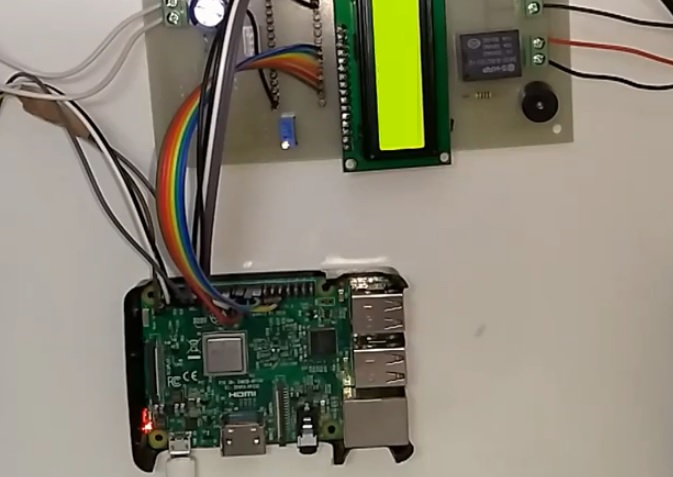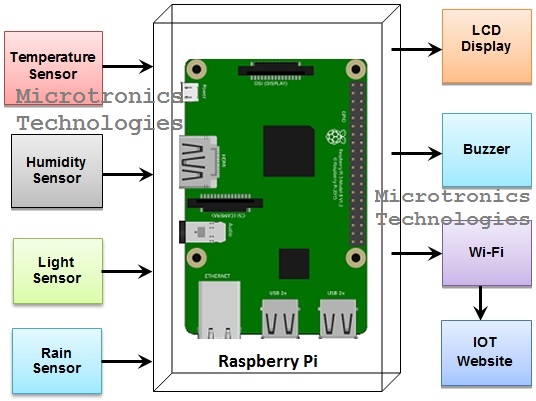Weather forecasts are very important for the functioning of our day-to-day lives. They also play a crucial role in agriculture, cattle farming, forestry, hydroelectric dams, wildfire monitoring, disaster management, and numerous other sectors. In the absence of effective weather monitoring systems, natural disasters, and ecological changes cannot be forecasted. It can result in economic loss and fatalities. The regional weather forecasts are generic in nature. They do not provide ample information about weather conditions in a specific area. The solution to this problem is the development of a Raspberry Pi based Weather Monitoring using IOT project.

₹ 9,900
Project Code: 6108

Introduction of the project
We need a local weather monitoring project in order to acquire more accurate and precise weather data from the local area. This local weather monitoring project employs four different sensors. These sensors are used for the monitoring of temperature, light, humidity, and rain parameters. The project is also IOT enabled which means that remote monitoring of local weather conditions is possible. Based on the information provided by this weather station project, heavy rains, excessive temperatures, storms, hurricanes, and snowfalls can be early forecasted. Therefore measures can be taken to avoid natural disasters and catastrophes. If any of the weather parameters exceed a specified level, a buzzer is turned on to alert the concerned personnel.
Operation of Raspberry Pi based Weather Monitoring using IOT
The Raspberry Pi based IOT enabled weather monitoring project consists of a power supply unit, weather sensors, a digital controller, an output display device, and a remote server. The power supply unit consists of a rectifier and a voltage regulator. This unit is responsible for supplying a stable 5V DC signal to all the DC-powered devices in the project. The project has four different sensors that gather the values of light, temperature, humidity, and rain from the atmosphere. These sensor values are continuously fed to a digital controller.
A Raspberry Pi single-board computer with built-in WiFi is used as a digital controller in our project. The Raspberry Pi controller stores and processes the sensor data and sends it to a remote web server by means of IOT communication protocols. The real-time sensor values are also displayed on an LCD screen. Thus, the gathered data can be monitored locally as well as remotely.
On the web server side, a graphical user interface can be developed to properly visualize the weather data in tabular or graph format. The system also contains a buzzer that goes on when any of the weather parameters exceed a specified level. This IOT enabled weather project can allow the concerned authorities to gather weather data from various localities, monitor it from a central control room and come up with relevant plans and policies.
Description of the block diagram
The block diagram of the Raspberry Pi based IOT enabled weather monitoring project consists of 8 sub-blocks.
- Power supply unit: It converts 230 VAC to 5 VDC. This block further consists of components like rectifiers, capacitors, and voltage regulator IC. The power supply unit provides stable 5 VDC power to the Raspberry Pi board and the LCD screen.
- Sensors: The next four blocks are the light, humidity, temperature, and rain sensors. These are the input devices that gather local weather data and transmit it to the Raspberry Pi controller.
- Raspberry Pi: The 6th block in the project block diagram is the Raspberry Pi board itself. It communicates with all the input and output devices in the project. It collects data from the sensors, stores this data, processes this data, and then transmits it to the output devices by means of physical wires as well as WiFi.
- The processed output from the Raspberry Pi board is sent off to two different systems.
- The first system consists of a buzzer and an LCD display which is also the 7th block in the block diagram. The real-time values of the weather sensors are displayed on the LCD unit.
- The second output system is the remote web server which is also the 8th block in the block diagram. The Raspberry Pi controller sends the sensor data to the remote web server by making use of onboard WiFi and IOT communication protocols. Once this data is successfully received on the server side, it can then be visualized using a graphical user interface.
Block diagram of the Raspberry Pi based Weather Monitoring using IOT project

Applications, advantages, and enhancements of the Raspberry Pi based Weather Monitoring using IOT project
- The Raspberry Pi based IOT enabled weather monitoring project can be used for the early detection of heavy rainfall. This early warning can help farmers to save their crops and also help in the water level management at hydroelectric dams.
- The Raspberry Pi based IOT enabled weather monitoring project can be used for the monitoring of excessive temperatures. This data can be used to help farmers, avoid heat strokes and predict forest fires.
- The Raspberry Pi based IOT enabled weather monitoring project provides accurate and precise weather-related data of a specific area as opposed to the generic type regional weather forecasts.
- The Raspberry Pi based IOT enabled weather monitoring project uses reasonably priced components and devices. This project provides a cost-effective weather monitoring solution.
- The Raspberry Pi based IOT enabled weather monitoring project provides remote monitoring capability. Using multiple monitoring devices, a smart weather monitoring network can be constructed which can help the concerned authorities in devising environmental plans and policies.
- The size of the weather monitoring project can be made more compact by using the Node MCU ESP8266 board instead of the Raspberry Pi board.
- Additional weather sensors can be added to the project in order to monitor more parameters and get more accurate weather data.
